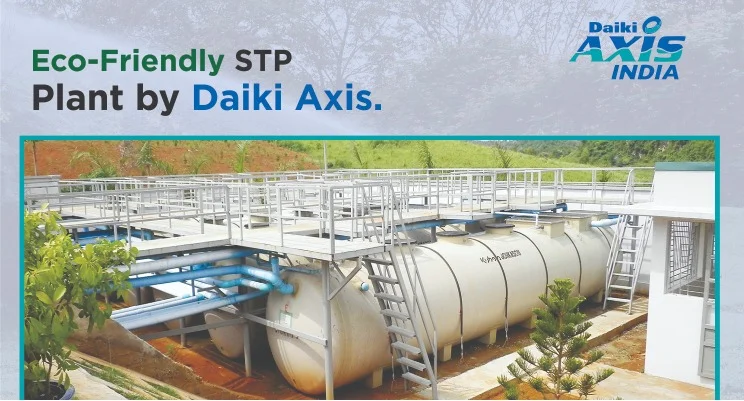- STP Plant Overview: A facility designed to treat and process wastewater to remove contaminants, making it safe for discharge or reuse.
- Treatment Processes: Utilizes a combination of physical, chemical, and biological processes to remove pollutants such as organic matter, solids, and harmful microorganisms.
- Treatment Stages: Includes stages like screening, sedimentation, aeration, and filtration to ensure effective treatment.
- Public Health and Environmental Protection: Plays a crucial role in protecting public health and the environment by preventing untreated sewage from polluting water bodies.
- Essential Infrastructure: Vital for both urban and rural areas, ensuring sustainable management of wastewater.
Daiki Axis India (STP Plant)
- Daiki Axis India, a subsidiary of Daiki Axis Japan, leads in water treatment solutions.
- Specializes in designing, manufacturing, and installing STP plants for the Indian market.
- Leverages advanced technology and expertise for sustainable wastewater management.
How does a sewage treatment plant work?
- Primary Treatment: Removes large solids through screening and sedimentation.
- Secondary Treatment: Uses biological processes to decompose organic substances.
- Tertiary Treatment: Further purifies the water by removing remaining nutrients and pathogens through filtration and disinfection.
- Final Process: The treated water is safe for discharge or reuse, while the residual sludge is treated and either disposed of or repurposed.
Daiki Axis India Sewage Treatment Plant Process
- Primary Treatment: Sewage flows into the primary chamber, allowing large solids to settle at the bottom while grease and oils float to the surface.
- Aeration: In the second chamber, air is introduced to foster aerobic bacteria growth, which breaks down organic matter.
- Secondary Treatment: Additional biological processes in the secondary chamber further reduce organic pollutants.
- Clarification: The water then moves to a clarification chamber where the remaining solids settle.
- Tertiary Treatment: Lastly, the treated water is disinfected to remove pathogens before being safely discharged or reused.
Wastewater treatment technologies, including Johkasou systems.
- Wastewater Treatment Technologies: Critical in managing water pollution and ensuring that discharged water is clean and safe for the environment.
- Goal: To remove contaminants, including organic and inorganic substances, pathogens, and other pollutants from wastewater.
- Purpose: To generate water that is safe for release back into the environment or suitable for various uses.
- Johkasou Systems: A key component in wastewater treatment, providing efficient and sustainable solutions for domestic and industrial wastewater management.
Emerging Trends and Innovations
- Resource Recovery: Technologies aimed at recovering valuable resources from wastewater, such as nutrients (e.g., phosphorus), biogas from anaerobic digestion, and water reuse.
- Smart Monitoring and Automation: Integration of sensors, real-time data analytics, and automation to optimize treatment processes and ensure regulatory compliance.
- Sustainable and Energy-Efficient Systems: Development of low-energy treatment technologies and the use of renewable energy sources to minimize the environmental footprint.
Government Initiatives and the Push for Improved Sanitation
- The Indian government has recognized the urgent need for enhanced water and sewage management systems. Initiatives such as the Swachh Bharat Mission (Clean India Mission) and the Namami Gange Project underscore the commitment to improving sanitation and urban infrastructure.
- Swachh Bharat Mission: Launched in 2014, this nationwide campaign aims to eliminate open defecation and improve solid waste management. A crucial component of this mission is the development of modern and effective sewage treatment solutions to ensure proper sanitation.
- Namami Gange Project: This ambitious initiative aims to rejuvenate the Ganga River by reducing pollution and restoring its ecological health. One of the project’s key aspects is the establishment of STPs along the river to treat sewage before it enters the Ganga, thus preventing contamination and improving water quality.
The State of Sewage Treatment in India
Despite significant progress, India’s sewage treatment capacity remains inadequate. According to the Central Pollution Control Board (CPCB), India generates approximately 72,368 million litres per day (MLD) of sewage, but the existing treatment capacity is only about 31,841 MLD. This gap highlights the urgent need for increased investment in sewage treatment infrastructure.
- Urban Areas: Only about 30% of sewage generated in urban areas is treated, leading to severe water pollution issues in rivers and lakes.
- Rural Areas: A significant portion of rural India relies on septic tanks and open defecation, lacking access to formal sewage treatment facilities.
Environmental Impact
- Positive Impacts:
- Reduces water pollution and prevents eutrophication.
- Promotes water reuse and resource recovery.
- Contributes to climate change mitigation through energy efficiency.
- Negative Impacts:
- High energy consumption and emissions.
- Sludge management challenges.
- Ecological risks from chemicals and infrastructure development.
- Mitigation Strategies:
- Focus on energy efficiency and sustainable sludge management.
- Adopt green technologies and comply with regulations.
Reuse
Implementing water reuse in STPs requires appropriate treatment processes to ensure the reclaimed water meets quality standards for the intended use. This practice, known as water reuse or reclaimed water reuse, has several environmental and economic benefits:
- Irrigation: Treated wastewater can be used for irrigation in agriculture, landscaping, and green spaces. This reduces the demand for freshwater resources and promotes sustainable water management practices.
- Industrial Uses: Industries can use reclaimed water for non-potable applications such as cooling water, process water, and cleaning operations. This conserves freshwater resources and reduces the environmental impact of industrial water consumption.
- Toilet Flushing: In buildings and communities, treated wastewater can be used for flushing toilets. This reduces the demand for potable water and lowers water bills for residents and businesses.
- Groundwater Recharge: Reclaimed water can be infiltrated into the ground to replenish groundwater aquifers. This helps sustain groundwater levels, especially in areas facing water scarcity or depletion.
- Environmental Protection: By reusing treated wastewater, STPs minimize the discharge of pollutants into rivers, lakes, and oceans, thereby protecting aquatic ecosystems and public health.
Conclusion: Towards a Cleaner and Healthier India
Daiki Axis India’s commitment to innovation, sustainability, and community engagement makes it a pivotal player in the quest for improved sewage treatment in India. By offering decentralized solutions tailored to the country’s diverse needs, the company is helping to bridge the gap between sewage generation and treatment capacity.
As government initiatives continue to drive the push for better sanitation, Daiki Axis India plays an essential role in translating policy into practice. Through their efforts, India can look forward to a future where clean water and effective sewage management are accessible to all, paving the way for a healthier and more sustainable nation.
Contact us at https://daikiaxis.in/contact-us/
Read more relevant blogs here: https://daikiaxis.in/blog/
#DaikiAxis #Johkasou #sewage #water #STP #DaikiSTP #STPplant
#PackagedSTP #JohkasouPrice #STPCompanies #STPPlant #SewageTreatmentPlantinDelhi #STPPlantManufactures #SewageTreatmentPlantManufacturesinIndia #johkasouSTP

